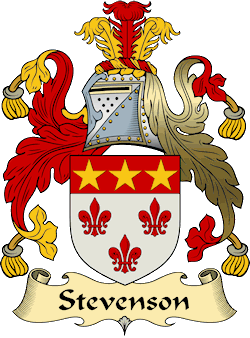Stevenson

Purchase Heraldry Products
Download Now!

Surname: Stevenson
Branch: Stevenson
Origins: Scottish
More Info: Scotland
|
|
Background: Stephen (which means 'crown' or 'wreath' or 'garland') has been a popular Christian name since the martyrdom of the saint of that name. The name was introduced into Britain by the Normans after 1066 and their influence spread into Scotland. Early records of the name include a deacon Stephen who witnessed a charter around 1150-71 and Ada, filius (son) of Stephani was a burgess of Elgin in 1286. Henricus Stepheni had a charter for land in Ayr in 1409 and a Nichol fitz Steven, chaplain of Scotland, had a license to take shipping between Scotland and London or Dover in England in 1372. The name became frequent all over the Lowlands of Scotland, but in the Gaelic-speaking Highlands there is no 'Mac' (son of) name derived from Stephen.
|
 Motto: Motto: Coelum, non solum; Heaven, not earth. Arms: Ar. a chev. betw. three fleurs-de-lis gu. on a chief or the last, as many mullets or. View the Heraldry Dictionary for help.

The name Stephen comes from the Greek "Stephanos" meaning wreath or garland. It is a biblical name first brought to these shores by the Normans prior to 1066. It was a popular name and spread rapidly through England into Wales and Ireland as well as Scotland. The Steven spelling tends to be more common in Scotland and Stevenson is "son of Steven". The name first appears (in one form or another) in old Scottish records as early as 1286 when Ada Stephani was a burgess of Elgin. Nichol Steven, chaplain of Scotland, had "license to take shipping at London or Dovorre at pleasure in 1372". John Steywynson was "one of the surveyors of the marches" near Banff in 1388. Henricus Stephani had a charter of land in Ayr in 1409. The origin and distribution of the name clearly indicates that they could not have been of one decent and that numerous lines evolved, particularly so with its establishment as a territorial name e.g. Stevenston (Steven's town), one of Ayrshire's "Three Towns" mentioned in a charter c1240. The name spread rapidly up the east coast as far north as Aberdeen where Stiven became common. Other variations included Steenson, Steinson and even Stein despite its Germanic appearance. Although never unified as a clan with a chief, some Stevensons acquired land holdings and established family lines which have contributed greatly to the rich history of Scotland. One of these, a Glasgow family, prospered in trading with the West Indies and were the forefathers of a great engineering dynasty. They built lighthouses (over 40), harbours, canals and drainage schemes. The most famous of the latter being the clearing of Edinburgh's Nor' Loch which became Princes Street Gardens. These Stevensons were responsible for many important engineering projects throughout the world and deserved greater recognition. They were rather overshadowed by the literary fame from their own next generation, i.e. Robert Louis Stevenson (1850-94) the author of many such classics as Treasure Island, Kidnapped and the macabre Dr. Jekyll and Mr. Hyde. Another, of Scottish decent was George Stephenson who gained note in England for his development of steam propulsion. Other, more recent, notables of the name include George Stephen (1829-1921) who pioneered the completion of the Canadian Pacific Railway and later took the title Lord Mount Stephen, after a peak named for him in the Rockies. Elsie Stephenson, trained as a nurse, and rose to become an adviser to the World Health Organisation and greatly influenced nursing studies throught the world. David D. Stevenson was Scottish Pole Vault Champion no fewer than ten times and represented Scotland in three successive Commonwealth Games. A tartan was designed in the 1970's by the late "Jack" Dalgetty of Forfar, one of the great scholars of tartan, for Bob Stephenson of Dundee and was based on an old sett in the records of Bolinbroke & Jones of Norwich and dated prior to 1870. It is not "restricted" and may be worn by all Stevensons and other variations in spelling.
Name Variations: Stevenson, Stephen, Stephanos, Stephani, Steven, Steywynson, Stevenston, Stiven, Steenson, Steinson, Stein.
References:One or more of the following publications has been referenced for this article.The General Armory; Sir Bernard Burke - 1842.
A Handbook of Mottoes; C.N. Elvin - 1860.
Scottish Clans and Tartans; Neil Grant - 2000.
Scottish Clan and Family Encyclopedia; George Way of Plean and Romilly Squire - 1994.
Scottish Clans and Tartans; Ian Grimble - 1973.
World Tartans; Iain Zaczek - 2001.
Clans and Families of Scotland; Alexander Fulton - 1991.
Electric Scotland: http://www.electricscotland.com/webclans/stoz/stevens2.html

|
|

The beautiful heraldry artwork for this family is available to purchase on select products from the Celtic Radio Store. We look forward to filling your order!

|
|
|
|
|